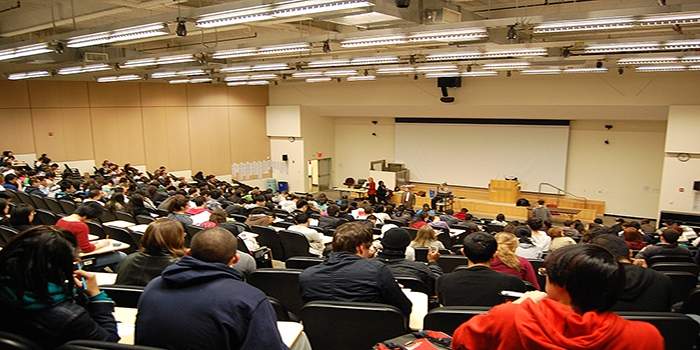Study finds students self-sort in active learning spaces, with potential to push women out
LAWRENCE — A recent trend in higher education has seen universities install more active learning spaces, in which students can move their seats, collaborate and interact with one another, as opposed to more traditional lecture halls. But, as space in the former is limited, little is known about which students choose them. A new study from the University of Kansas found that students initially choose based on their social networks. That self-sorting, however, has the potential to push some students, most often women, from undergraduate programs.
 KU researchers observed students taking part in an organic chemistry course over the course of an academic year. Classes were offered in both an active learning space and a traditional, larger lecture hall with fewer active learning supports. Researchers found that more women chose the active spaces, and that at the semester break, there was an additional, substantial shift in who chose the active spaces.
KU researchers observed students taking part in an organic chemistry course over the course of an academic year. Classes were offered in both an active learning space and a traditional, larger lecture hall with fewer active learning supports. Researchers found that more women chose the active spaces, and that at the semester break, there was an additional, substantial shift in who chose the active spaces.
Initially, results showed students largely chose based on their social networks. FIrst, they looked at where the class was offered. They then relied on what friends told them about the spaces when making their choice. However, when researchers interviewed students again at the semester break, they found those most interested in switching to an active learning space or continuing there were more focused on learning chemistry like an expert. And the majority interested in active spaces were women.
“The vast majority of students who wanted to take classes in active learning spaces were women,” said Michael Ralph, doctoral candidate in educational psychology at KU and the study’s lead author. “Many were also honors students. These students prioritized learning about chemistry both in and outside the classroom. This became even more apparent by mid-semester, as more women wanted to transfer to the active learning rooms but couldn’t because of limited space.”
The study, written with co-authors Blair Schneider, Kansas Geological Survey; David Benson, associate professor of chemistry; and Doug Ward, associate director of KU’s Center for Teaching Excellence, was published in the journal Active Learning in Higher Education.
The research team previously published a study that found women and honor students tended to prefer the active learning spaces. While that study observed a moment in time, the current study aimed to better understand how students arrived at their learning space choices over time. But as the active learning spaces are limited, only a finite number of students can take those classes. Given that, the researchers wanted to understand more about how decisions were made by students from historically underrepresented groups.
The data showing that students who preferred active learning spaces were those who tended to think about the sciences outside of class suggested students who were beginning to think like expert chemists preferred the active spaces, Ralph said. That, combined with data that shows women and honor students prefer the spaces as well, suggests active learning spaces are valued by the students most likely to continue into graduate programs in the sciences and with potential for high achievement. Better understanding why students choose the active learning spaces, and why women were showing such a strong preference for them, can help reduce barriers to success for women in physical science and STEM more broadly.
While the current study did not examine factors such as race, socioeconomic status and other considerations that have been historically marginalized in the sciences, it can help open the door to those types of questions in the future, while simultaneously better understanding how active learning spaces serve students, whether they help retain highly qualified students and how higher education can best support young students interested in the sciences.
“We hear from women that they are looking for these types of spaces,” Ralph said. “So we used a statistical approach to examine how they makes choices about classrooms. It was helpful to be able to ask these questions directly and interesting to see the self-sorting that took place. Showing how some of these formative moments affect the students’ future choices and opportunities may allow us to help students earlier.”
Image: Students in a traditional lecture hall. Source: Wikimedia commons.